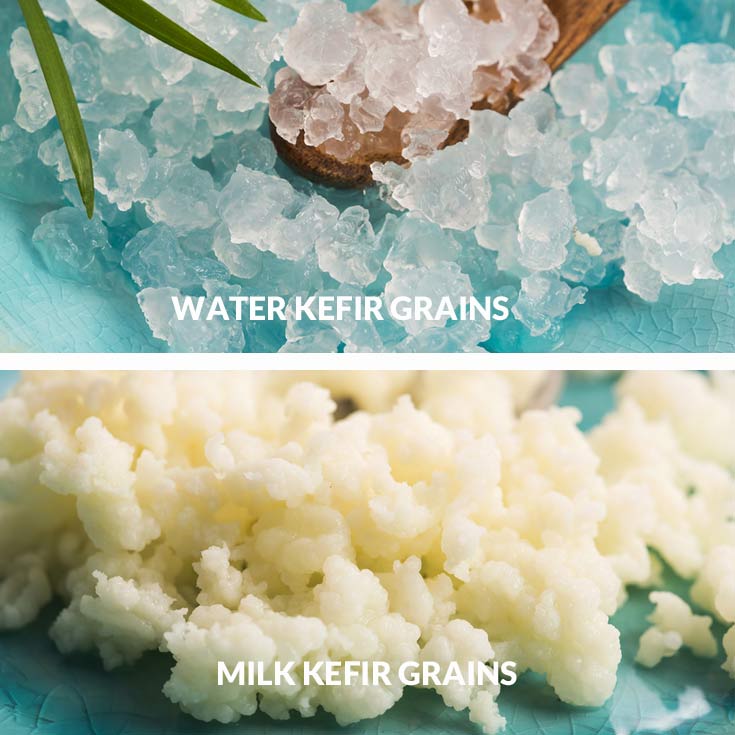To make your own Kefir cultures at home is easy. First you choose the type of Kefir you want to make
- Milk Kefir
- Water Kefir
- Coconut Water Kefir
(Descriptions of what the different cultures taste like.)
Then you decide on the culture starter you want to use to make it. There are 2 types:
- Grains (A gelatinous substance known as Kefir grains, not a real grain.)
- Commercial Powdered Starters
Milk Kefir and coconut Kefir can be started using both grains and powdered starters, Water Kefir can only be made using grains.
You then combine either your milk, water or coconut water with your chosen starter, and leave at room temperature for a period of time, usually 1 to 2 days, after which it is ready to drink.
How To Make Milk Kefir Using Powdered Starters
Powdered starters such as Body Ecology’s Kefir Starter can be purchased. An individual sachet can be used to make more than one batch. The Body Ecology Kefir starter makes 7 batches per sachet (other brands may differ). A box comes with 6 sachets so there is 42 batches that can be made from one starter kit.
A sachet is simply added to milk in a jar with a tight lid and left for 18-24 hours. It is then ready to use. To make your next batch simply transfer some of the initial batch to a fresh lot of milk and repeat the process.
Advantages to using a powdered starter are the cultures are potent and controlled so you are assured of only beneficial bacteria. They contain less yeast strains so won’t risk contributing or worsening candida yeast infections. They also may be more convenient for those who don’t want to make Kefir continuously. Body Ecology’s Kefir Starter can also be used to make coconut water Kefir.
How To Make Milk Kefir Using Grains
To make milk Kefir with grains involves combining the grains with milk in a jar with a cloth cover, leaving at room temperature for a period of time, then straining and reusing.
Grains can be used indefinitely, but must be continuously brewed to keep the culture alive. It is possible to slow down the metabolic rate of the culture by placing it in the fridge (called resting), although they will still need some care during the ‘resting’ period, and may take time to regain their potency after resting.
Grains contain a wide variety of bacteria and yeasts. While the exact bacteria and yeast make-up of your grains will be unknown, they are considered safe for consumption.
You can purchase grains or you may find someone on a fermenting Facebook group that can help. Grains multiply so fellow fermenters often have some extra to share.
How To Make Water Kefir
Water Kefir is also made using ‘grains’, but these are different from milk grains and cannot be used to make milk kefir. They can be used to make coconut water kefir. The process is simple, adding the grains to sweetened water, often with added fruit. After a period of 1 or 2 days the water is bottled and the grains reused.
How To Make Coconut Water Kefir
Coconut water kefir can be made from water Kefir grains, or from Body Ecology’s Kefir Starter in a similar process to other types of kefir.
What do I do with my Kefir?
Water kefir makes a great healthy fizzy drink that kids will love. Experiment with different fruit flavourings for some fun.
Coconut water Kefir is a wonderful tonic that helps curb a sweet tooth and aids digestion.
Milk Kefir is pleasant on it’s own, or you can flavour it or sweeten it for variety. Blend it with some berries and a pinch of stevia for a healthy drink at breakfast. Mix in Cacao Powder and a touch of honey for a rich chocolate drink. Use in smoothies, with cereal or an Acai Bowl. Mix with lemon juice for a salad dressing or make into Kefir cheese.
Tips For Making Kefir
No metal – use glass jars, plastic spoons and equipment. If you use grains you will need a plastic sieve, you can get these at $1 stores.
Water – use spring or mineral water. The bacteria don’t like fluoride.
Milk – for milk kefir you can use Raw, pasteurized, low fat, goat etc. Must be dairy, no nut milks as the bacteria need the lactose.
Read More In Our Good Gut Health Series
Understanding Your Gut Health & Microbiome
Difference between Probiotics & Prebiotics
What Is Kefir & How Does It Taste?
Using Kefir In A Recipe – Greek Tzatziki Sauce
How To Make Fermented Vegetables
Using Fermented Vegtable In A Recipe – Water Cress Salad

